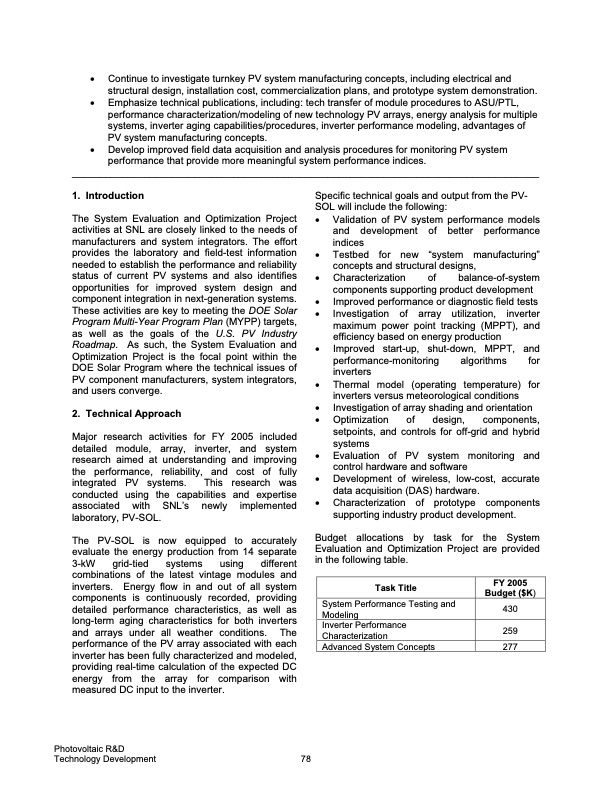
PDF Publication Title:
Text from PDF Page: 084
• Continue to investigate turnkey PV system manufacturing concepts, including electrical and structural design, installation cost, commercialization plans, and prototype system demonstration. • Emphasize technical publications, including: tech transfer of module procedures to ASU/PTL, performance characterization/modeling of new technology PV arrays, energy analysis for multiple systems, inverter aging capabilities/procedures, inverter performance modeling, advantages of PV system manufacturing concepts. • Develop improved field data acquisition and analysis procedures for monitoring PV system performance that provide more meaningful system performance indices. ____________________________________________________________________________________ 1. Introduction The System Evaluation and Optimization Project activities at SNL are closely linked to the needs of manufacturers and system integrators. The effort provides the laboratory and field-test information needed to establish the performance and reliability status of current PV systems and also identifies opportunities for improved system design and component integration in next-generation systems. These activities are key to meeting the DOE Solar Program Multi-Year Program Plan (MYPP) targets, as well as the goals of the U.S. PV Industry Roadmap. As such, the System Evaluation and Optimization Project is the focal point within the DOE Solar Program where the technical issues of PV component manufacturers, system integrators, and users converge. 2. Technical Approach Major research activities for FY 2005 included detailed module, array, inverter, and system research aimed at understanding and improving the performance, reliability, and cost of fully integrated PV systems. This research was conducted using the capabilities and expertise associated with SNL’s newly implemented laboratory, PV-SOL. The PV-SOL is now equipped to accurately evaluate the energy production from 14 separate 3-kW grid-tied systems using different combinations of the latest vintage modules and inverters. Energy flow in and out of all system components is continuously recorded, providing detailed performance characteristics, as well as long-term aging characteristics for both inverters and arrays under all weather conditions. The performance of the PV array associated with each inverter has been fully characterized and modeled, providing real-time calculation of the expected DC energy from the array for comparison with measured DC input to the inverter. Photovoltaic R&D Technology Development Specific technical goals and output from the PV- SOL will include the following: • Validation of PV system performance models and development of better performance indices • Testbed for new “system manufacturing” concepts and structural designs, • Characterization of balance-of-system components supporting product development • Improved performance or diagnostic field tests • Investigation of array utilization, inverter maximum power point tracking (MPPT), and efficiency based on energy production • Improved start-up, shut-down, MPPT, and performance-monitoring algorithms for inverters • Thermal model (operating temperature) for inverters versus meteorological conditions • Investigation of array shading and orientation • Optimization of design, components, setpoints, and controls for off-grid and hybrid systems • Evaluation of PV system monitoring and control hardware and software • Development of wireless, low-cost, accurate data acquisition (DAS) hardware. • Characterization of prototype components supporting industry product development. Budget allocations by task for the System Evaluation and Optimization Project are provided in the following table. FY 2005 Task Title Budget ($K) System Performance T esting and Modeling 430 Inverter Performance 259 Characterization Advanced System Concepts 277 78PDF Image | DOE Solar Energy Technologies Program

PDF Search Title:
DOE Solar Energy Technologies ProgramOriginal File Name Searched:
38743.pdfDIY PDF Search: Google It | Yahoo | Bing
NFT (Non Fungible Token): Buy our tech, design, development or system NFT and become part of our tech NFT network... More Info
IT XR Project Redstone NFT Available for Sale: NFT for high tech turbine design with one part 3D printed counter-rotating energy turbine. Be part of the future with this NFT. Can be bought and sold but only one design NFT exists. Royalties go to the developer (Infinity) to keep enhancing design and applications... More Info
Infinity Turbine IT XR Project Redstone Design: NFT for sale... NFT for high tech turbine design with one part 3D printed counter-rotating energy turbine. Includes all rights to this turbine design, including license for Fluid Handling Block I and II for the turbine assembly and housing. The NFT includes the blueprints (cad/cam), revenue streams, and all future development of the IT XR Project Redstone... More Info
Infinity Turbine ROT Radial Outflow Turbine 24 Design and Worldwide Rights: NFT for sale... NFT for the ROT 24 energy turbine. Be part of the future with this NFT. This design can be bought and sold but only one design NFT exists. You may manufacture the unit, or get the revenues from its sale from Infinity Turbine. Royalties go to the developer (Infinity) to keep enhancing design and applications... More Info
Infinity Supercritical CO2 10 Liter Extractor Design and Worldwide Rights: The Infinity Supercritical 10L CO2 extractor is for botanical oil extraction, which is rich in terpenes and can produce shelf ready full spectrum oil. With over 5 years of development, this industry leader mature extractor machine has been sold since 2015 and is part of many profitable businesses. The process can also be used for electrowinning, e-waste recycling, and lithium battery recycling, gold mining electronic wastes, precious metals. CO2 can also be used in a reverse fuel cell with nafion to make a gas-to-liquids fuel, such as methanol, ethanol and butanol or ethylene. Supercritical CO2 has also been used for treating nafion to make it more effective catalyst. This NFT is for the purchase of worldwide rights which includes the design. More Info
NFT (Non Fungible Token): Buy our tech, design, development or system NFT and become part of our tech NFT network... More Info
Infinity Turbine Products: Special for this month, any plans are $10,000 for complete Cad/Cam blueprints. License is for one build. Try before you buy a production license. May pay by Bitcoin or other Crypto. Products Page... More Info
| CONTACT TEL: 608-238-6001 Email: greg@infinityturbine.com | RSS | AMP |